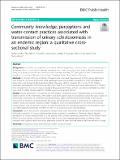Community knowledge, perceptions and water contact practices associated with transmission of urinary schistosomiasis in an endemic region: a qualitative crosssectional study

View/
Date
2019-06-07Author
Angelo, Teckla
Kinung’hi, Safari
Buza, Joram
Mwanga, Joseph
Kariuki, Henry
Wilson, Shona
Metadata
Show full item recordAbstract
Background: In an effort to complement the current chemotherapy based schistosomiasis control interventions in
Shinyanga district, community knowledge, perceptions and water contact practices were qualitatively assessed
using focus group discussions and semi structured interviews involving 271 participants in one S. haematobium
prevalent community of Ikingwamanoti village, Shinyanga district, Northwestern, Tanzania.
Methods: In October, 2016 we conducted 29 parent semi structured interviews and 16 focus group discussions
with a total of 168 parent informants. Adult participants were conveniently selected from three sub-villages of
Butini, Miyu, and Bomani of Ikingwamanoti village, Shinyanga district. In March, 2017, a total of 103 children
informants participated in 10 focus group discussions and 20 semi structured interviews, administered to children
from standard four, five, six and seven attending Ikingwamanoti Primary School. Note taking and digital recorders
were used to collect narrative data for thematic analysis of emergent themes.
Results: Among participants, 75% parents and 50% children considered urinary schistosomiasis as a low priority
health problem. Of the informants, 70% children and 48.3% parents had misconceptions about the cause, modes of
transmission and control of schistosomiasis demonstrating gaps in their biomedical knowledge of the disease.
Assessment of treatment seeking behavior for urinary schistosomiasis revealed a combination of traditional and
modern health care sectors. However, modern medicines were considered effective in the treatment of urinary
schistosomiasis. Lack of alternative sources of water for domestic and recreational activities and unhygienic water
use habits exposed community members to high risk of acquiring urinary schistosomiasis.
Conclusion: Use of Schistosoma haematobium contaminated water sources for daily domestic and recreational use
facilitated contraction of urinary schistosomiasis among community members in Shinyanga district. People’s
perceptions of urinary schistosomiasis as a less priority health problem promoted persistence of the disease. Future
efforts to control urinary schistosomiasis should take into account integrated approaches combining water,
sanitation and hygiene, health education, alternative sources of clean and safe water to facilitate behavior change.
